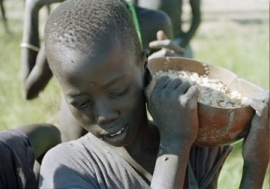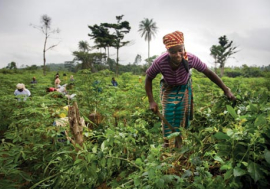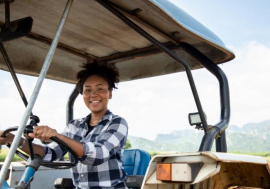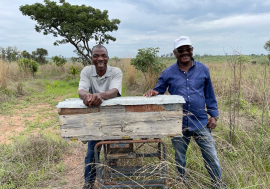Africa starts a fishing ‘revolution’
Africa starts a fishing ‘revolution’
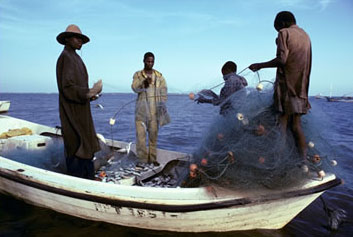 Africa's small-scale fishers want environmental protection, higher incomes and a greater voice.
Africa's small-scale fishers want environmental protection, higher incomes and a greater voice.At the base of the Zomba plateau in southern Malawi, more and more villagers are digging ponds to raise fish. Mr. James Chitonya previously grew maize, with meagre returns. But since he began practicing “fish farming” (also known as “aquaculture”) several years ago, he has earned enough from fish sales to replace his thatched grass hut with a house that has electricity and an iron-sheet roof. “I am also able to pay school fees for my children and buy them clothes,” he told a local reporter. “In addition, I have bought some livestock from the sales of fish.”
Several thousand kilometres away, in the village of Nianing on Senegal’s coast, hundreds of women clean and smoke the 50 tonnes of fish caught annually by kinfolk and neighbours, who venture into the Atlantic in canoes. The women’s processed fish is sold to residents or to companies for export to Asia, principally Japan. Concerned that overfishing was beginning to deplete the stocks of offshore fish, Nianing’s fishers and fish processors welcomed support from the Senegalese government and the Japanese aid agency to improve management of fishing, the village’s economic mainstay. Not only are these artisans now better organized than they were a few years ago, but they have learned to observe prohibitions against catching certain species at given times of the year, so the fish have time to replenish their numbers. Since the project began, the value of Nianing’s total fish output has increased by almost half.
Initiatives such as these must be replicated across Africa if the continent is to harness the full promise of its fisheries to strengthen national economies, reduce poverty and improve people’s food security and nutrition, argue promoters of the New Partnership for Africa’s Development (NEPAD). The continent-wide plan, first adopted by African leaders in 2001, is intended to accelerate Africans’ own development efforts, draw greater benefits from external economic dealings and advance good governance, peace and security.
Since NEPAD’s advent, teams of experts have begun developing action plans for specific sectors, such as agriculture, health and the environment. At a special Fish for All summit meeting in Abuja, Nigeria, in August 2005, African leaders launched the “NEPAD Action Plan for the Development of African Fisheries and Aquaculture.”
In a concluding summit declaration, the leaders expressed alarm over the depletion of Africa’s fish stocks, the degradation of its aquatic environments and threats to the sustainability of its fisheries and aquaculture, especially as the demand for fish is rising sharply. To overcome such challenges, they vowed action to realize “increased benefits from sustainable fisheries and aquaculture.”
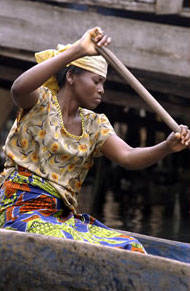 Half of all those employed in Africa’s fishing sector are women.
Half of all those employed in Africa’s fishing sector are women.In Senegal, as elsewhere in Africa, “Fishing is on the way to revolutionizing itself,” Minister of the Maritime Economy Djibo Kâ stated just a few days after the Abuja summit. Such a revolution is all the more urgent, he added, because the fishing sector as a whole is “in crisis.”
A stagnating resource
Although fishing in much of rural Africa tends to be overshadowed by agriculture and stockraising, it is not a marginal sector. Fishing provides direct incomes for about 10 million people — half of whom are women — and contributes to the food supply of 200 million more.
According to the WorldFish Centre, an independent research institute headquartered in Malaysia, Africans rely on fish for an average of 22 per cent of their consumption of animal protein. In some countries, the rate is as high as 70 per cent. Fish also provides essential vitamins, minerals, fatty acids and other nutrients crucial to a healthy diet. The poor rely on fish more than others, because it is often the most affordable source of protein.
Fishing also makes a significant economic contribution. In Uganda, for example, lake fisheries yield catches worth more than $200 mn a year, contributing 2.2 per cent to the country’s gross domestic product. They employ 135,000 fishers and 700,000 more in fish processing and trading, and generate $87.5 mn in export earnings.
Overall, African fish exports increased notably during the 1980s and 1990s. By 2001 they reached a value of $2.7 bn — about 5 per cent of the total global trade of $56 bn. According to the UN Food and Agriculture Organization (FAO), fish products make up more than 10 per cent of the total value of national exports in 11 African countries.
But under current fishing practices and management methods, Africa’s marine and inland fisheries are reaching their limits. Too many fish are being caught, so stocks are dwindling. Mr. Daniel Pauly, a researcher at the University of British Columbia in Canada, estimates that with the tripling of fishing activity in northwest Africa since the 1970s, the amount of fish in deep waters has fallen by a quarter. Off West Africa, deep-water fish stocks have declined by half. “This trend is also evident farther south,” he says, “along the African coast down to Namibia.”
The NEPAD Action Plan observes that during the 1980s and 1990s, fish caught in marine and inland waters increased steadily, rising to an average of 7.3 mn tonnes. But output has stagnated since then, reaching only 6.8 mn tonnes in 2002.
Mr. Claude Martin, director-general of the World Wildlife Fund International, notes that a decline in fish output could seriously affect local food security. “A collapse of fish stocks in West Africa,” he said, “can have more serious human consequences than in Europe or North America,” the destinations for most of the region’s fish exports.
Towards sustainability
Through negotiated agreements between European and African governments, hundreds of European vessels fish annually off Africa’s coasts. These agreements stipulate the types and volumes of fish that can be caught and the royalties and fees the foreign ships must pay to operate in African waters.
But many African countries lack sufficient boats, aircraft, communications equipment and trained personnel to effectively monitor the activities of foreign vessels, to make sure they do not overfish. Sometimes African governments, eager to earn foreign revenue, simply agree to let European fleets catch more fish than they should.
The NEPAD Action Plan argues that in marine fisheries, “arrangements that regulate the access of foreign fleets to African fish stocks need to be considered from a long-term perspective on fish supply and economic development opportunities.”
In recent years, a number of African governments have been taking a tougher line when negotiating foreign fishing agreements. In addition to prohibiting fishing during certain times of the year and limiting the overall catch, the new agreements often channel part of the fees paid by the foreign vessels towards strengthening African countries’ surveillance capacities. Since many fishing zones cross maritime boundaries, neighbouring African countries are also working more closely together to improve monitoring and resolve any disputes that may arise.
Getting foreign ships to operate more responsibly is only part of the challenge, notes Mr. Arona Diagne, president of Senegal’s National Association of Fishers. “Senegalese boats plunder more of the sea’s resources than do foreign ships,” he admits. “When fishers come across a school of fish, they want to take them all.” One solution, Mr. Diagne argues, is to teach them to fish more sustainably. Another is to invest in fish-processing enterprises, cold storage units, marketing facilities and other infrastructure that will increase incomes and minimize losses, thereby easing the economic pressure to catch so many fish.
Overall, argues the NEPAD Action Plan, African governments need to work together with the private sector to channel more investment into various forms of infrastructure. In both coastal and inland fisheries, these would include landing sites, cold units, road and transport systems and marketing facilities. To make sure that fishing better helps reduce poverty, it is also important to target enterprise-support programmes, credit institutions and technical assistance towards small-scale fishers and women fish processors.
Across the continent, says the plan, African countries need to develop their capacities to catch and process their own fish. This will help ensure that “revenues and economic rent generated by the sector are reinvested into development interventions.”
Involving communities
Reforming the way fisheries are managed will also be essential for bringing more of the sector’s benefits to those who do the actual work. In the development of both national and local policies, notes the NEPAD plan, there is currently a “general underrepresentation of fishing communities in the decision-making process.”
Therefore, it states, governments must act to build the capacity of all stakeholders to engage in fisheries management; develop “co-management plans” that include government ministries and agencies, the private sector, associations of fishers and fish processors and non-governmental organizations (NGOs); and create decentralized government structures with transparent mechanisms of control and audit.
Failing to work with all local actors can have dire consequences. In the mid-1990s, this writer visited Kétonou, a fishing village near the coast of Benin. A group of leading villagers, with funding from a French environmental NGO, had created a restricted fish “park” in the marshes. Fishing there was only allowed by permit, supposedly to prevent overfishing and safeguard sustainability. In fact, the project was run by two “deflatés” (retrenched former civil servants) and traditional elders. They and a small group of better-off villagers received permits, while the big majority of poor villagers were excluded.
Tensions of a different sort emerged in the Senegalese fishing town of Kayar in June 2005. Local residents, who had long observed fishing restrictions, became frustrated when the authorities did little to stop seasonal fishers from further north from violating the prohibitions. Their anger broke out in a day of violent protests and clashes with police that left 30 people injured and one dead. In such cases, community participation in decision-making could have helped resolve the conflict before it spiralled out of control.
Aquaculture: ‘sector of the future’
Improving the efficiency and sustainability of Africa’s marine and inland fisheries will help boost overall production to some extent. But they alone will not be able to meet the continent’s growing domestic demand for fish nor increase exports on a significant scale. The NEPAD Action Plan therefore singles out aquaculture as the sector with the greatest potential for expansion.
Fish farming has been practiced in Asia for hundreds of years. It was introduced into Africa more than a century ago, but with only a very modest impact here and there. Only in the last decade or so has aquaculture begun to take hold, with overall production rising from 80,000 tonnes in 1990 to more than 530,000 tonnes in 2003 (see graph). But this is still only a small fraction of the continent’s total fish output.
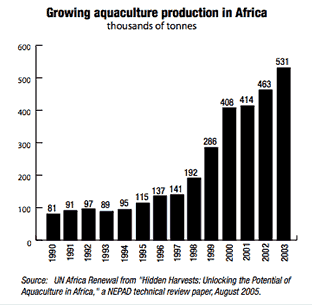
By far the greatest contribution to Africa’s increase in aquaculture production has come from Egypt, which produced about 400,000 tonnes in 2004. By combining traditional aquaculture techniques, improved management of water resources and the private initiative of thousands of small enterprises involved in production, marketing and servicing, Egypt is now able to meet about half of its national demand for fish from aquaculture.
Nigeria is Africa’s second-largest producer of fish from aquaculture, with more than 30,000 tonnes recorded in 2003. Madagascar comes next, with under 10,000 tonnes.
Even in countries where production is still very low, as in Mozambique, which produced just 855 tonnes in 2003, the sector is winning greater attention. Fish farming, says Ms. Isabel Omar, an aquaculture expert in Mozambique’s fisheries ministry, “plays an important role in the socioeconomic development of the country” by improving people’s diets through the provision of low-cost protein, creating jobs and enhancing rural incomes.
According to studies by the FAO, about 9.2 mn square kilometres (31 per cent of the land area) of sub-Saharan Africa is suitable for smallholder fish farming. If the yields achieved in recent fish-farming projects can be maintained on a wide scale, devoting only 0.5 per cent of this land area to aquaculture would be sufficient to meet a third of Africa’s additional demand for fish by 2010.
The experience of aquaculture ventures in Africa indicates that attempts to introduce fish farming as a separate activity generally do not have a great impact. But when fish farming is combined with crop cultivation or stockraising, villagers are more willing to adopt the practice. Yields also tend to be much higher. Crop residues can provide nutrients to help the fish mature, while runoff of enriched water from fish ponds can help fertilize crops. Irrigated rice farming provides many such opportunities.
If aquaculture output can grow by an average of 10 per cent a year, argues a technical paper distributed at the August 2005 Fish for All summit, then Africa will be able to reach about 3 mn tonnes over the next 15 years. Such growth could create at least 5 mn additional jobs, help feed millions more and yield another $50 mn—$100 mn in export revenues.
According to Mr. Kâ, Senegal’s maritime economy minister, experts have identified about 700 high-potential aquaculture sites in that country. Of those, only 59 are now being exploited, many directly linking fish farming with rice cultivation. Nevertheless, he says, fish farming is “the sector of the future.”
In January, Senegalese Prime Minister Macky Sall inaugurated the stocking with about 70,000 “fingerlings” (very young fish) of three large fish basins near the town of Tivaouane. He announced that the government had just approved an allocation of CFA18.5 bn (about US$35 mn) for aquaculture, towards a goal of developing 7,500 fish ponds, with an estimated yield of 100,000 tonnes, by 2010.
The stocking of the basins, Mr. Sall said, marked the beginning of a “new era” in Senegal’s fishing industry. “The challenges of sustainable development require new approaches in the search for solutions to the acute problem of food security.”










